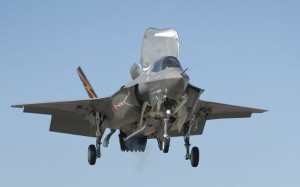
F-35B development aircraft BF-1 performed the JSF’s first vertical landing on March 18 at NAS Patuxent River near Washington.
Pilot Graham Tomlinson (a former RAF Harrier pilot) put the aircraft down on a Pax River ramp smoothly after slowing to a hover, as can be viewed here. The vertical landing came just one day after the aircraft’s first free hover about 150ft above the runway for about two minutes.
The milestone landing flight had begun with an 80kt very short takeoff, with the lightly loaded aircraft rotating just six to eight seconds after brake release. The vertical landing encountered little of the predicted ground effect tubulence that was expected, with Tomlinson telling media afterwards that he “felt very light cobblestones, far lower than in other (STOVL) aircraft. The loads, thermal, air data and control law guys were all smiling. Today’s vertical landing onto a 95ft square pad showed that we have the thrust and the control to manoeuvre accurately both in free air and in the descent through ground effect.”
“Having the F-35B perform its first vertical landing underscores the reality of the Marine Corps achieving its goal of an all STOVL force,” said Lt Gen George Trautman, the US Marine Corps’s deputy commandant for aviation. “Being able to operate and land virtually anywhere, the STOVL JSF is a unique fixed wing aircraft that can deploy, co-locate, train and fight with Marine ground forces while operating from a wider range of bases ashore and afloat than any other tacair platform.”
After the March 17 hover test, BF-1 made a slow landing at 60kt, and following a quick turnaround, performed a short takeoff in less than 1000ft of runway at 100kt.
The vertical landing milestone is a key test and proving point for the program, and comes between two years and 10 months later than previous schedules.












